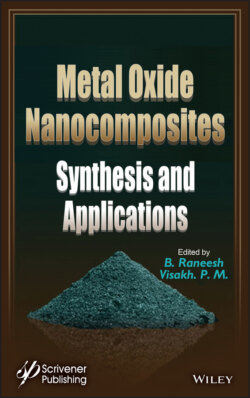Читать книгу Metal Oxide Nanocomposites - Группа авторов - Страница 81
3.5 Graphene-Based Hybrid Nanocomposites
ОглавлениеApart from the graphene-based inorganic composites, there are graphenebased hybrid nanocomposites which employ the use of nanostructures namely metal-organic frameworks, carbon nanotubes, biomaterials, etc., and have been essentially investigated for various applications (e.g. Li-ion batteries, supercapacitors, fuel cells, photovoltaic devices, etc.) as represented in Figure 3.5. Metal-organic frameworks (MOF)-graphene based nanocomposites, has been investigated for storage applications and gas purification. Like as, MOF-5 (a zinc-based MOF) and graphite oxide (GO) nanocomposites have been synthesized, further been investigated for ammonia adsorption, and the results revealed their higher dispersive forces than MOF alone which attributed for more adsorption of gas [35].
Figure 3.5 Types of Graphene-based hybrid nanocomposites and their synthesis approaches.
Similarly, HKUST-1(a copper-based MOF) and GO, has been synthesized, further been investigated for NO2 adsorption under dry and moist conditions, and the results revealed their high-performance efficiency is owing to their amplified porosity and the reactive adsorption sites on copper-based MOF [36]. Also, Zr-based metal-organic framework (Zr-MOF) and reduced graphene oxide (rGO), has been synthesized by in-situ approach and further been investigated for hydrogen storage applications. The presented experimental studies displayed upsurges surface area characteristics for the rGO/Zr-MOF nanocomposite concerning pristine Zr-MOF, which resulted in boosted hydrogen storage capacity of rGO/Zr-MOF nanocomposite [37]. Furthermore, biomaterials like DNA, aptamers, antibodies, enzymes etc. has been decorated onto graphene to form hybrid graphene nanocomposites and has potential applications in sensing, cell-imaging and probing living cells. An example of biomaterial, i.e. single-stranded DNA (ss-DNA)-graphene nanocomposite has been synthesized, and its potential application in electrochemistry is investigated. The ss-DNA/Graphene nanocomposite offers a novel biographene hybrid electrochemical platform for the biological determination of redox enzymes [38]. Similarly, double-strand DNA (ds-DNA) and gold nanorods (GNRs) has been decorated onto graphene oxide, thereby fabricating a sandwich-modified electrode composed of GNRs/ds-DNA/GO for the electrochemical sensing of diazinon (DZ), a pesticide based on amperometry [39]. Carbon nanotubes-graphene based nanocomposites have been synthesized by solution blending or CVD, and have been functional in applications like Li-ion batteries, supercapacitors, fuel cells, conductors, photovoltaic devices, etc. Like as synthesis of graphene nanosheets-supported carbon-nanotube-Sn nanorods based nanocomposite was engaging in-situ CVD method. This nanocomposite represents extraordinary energy storage abilities and outstanding performance like as efficient anodes for Li-ion battery (LIB) applications [40]. Similarly, nitrogen-doped graphene/carbon nanotube nanocomposites have been synthesized by hydrothermal treatment of graphene oxide, oxidized multiwalled carbon nanotube and ammonia at 180°C. This nanocomposite reveals it boosted electrochemical activities and acts as an effectual electrocatalyst for the oxygen reduction reaction with positive onset, large current, and robust durability [41].
